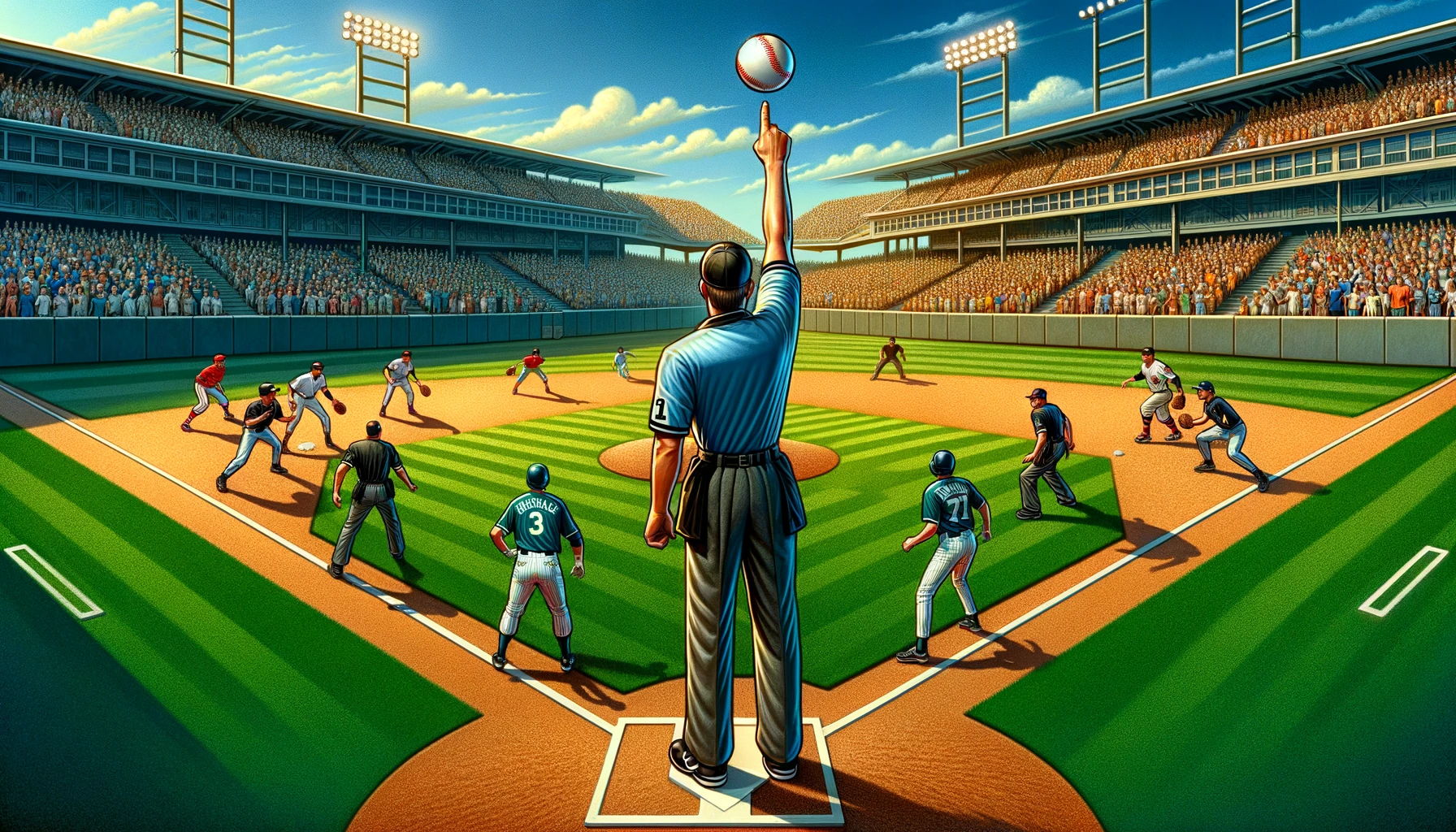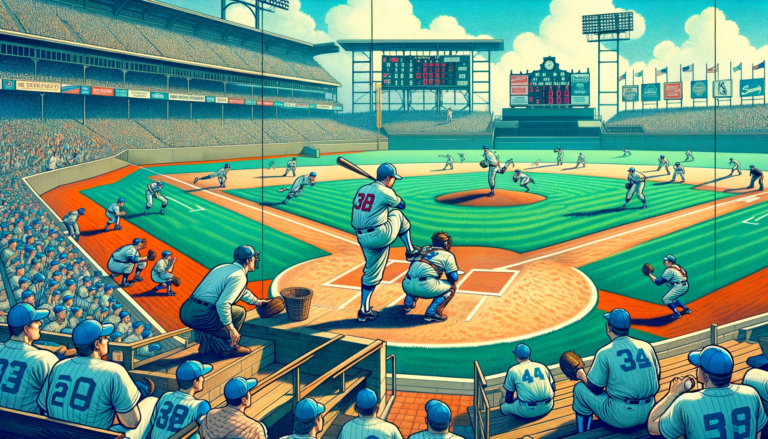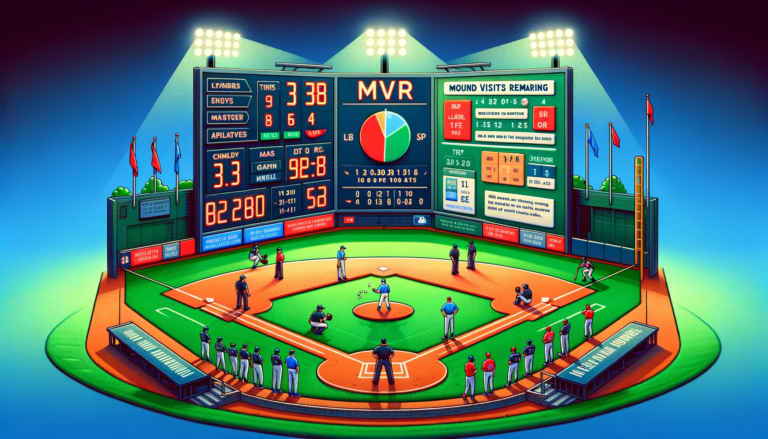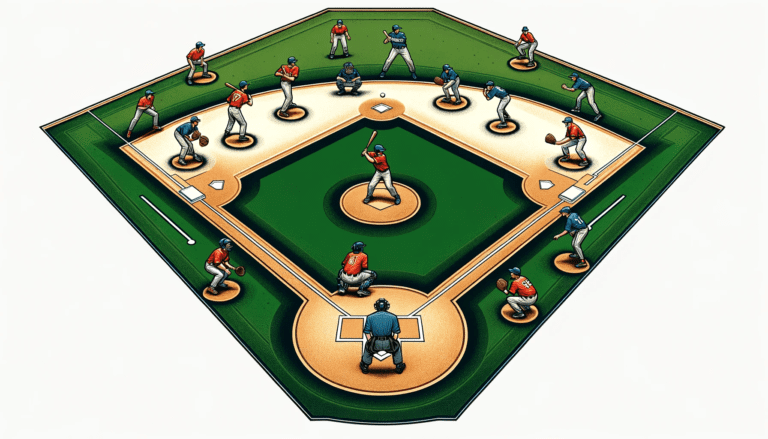What is an Infield Fly Rule in Baseball?
In baseball, the infield fly rule stops infielders from dropping a pop-up on purpose. They might do this to make it easier to get runners out.
When this rule kicks in, the hitter is automatically out if they hit a fair ball that goes up high and the umpire thinks an infielder could catch it without too much trouble.
This has to happen when there are runners on first and second base, or when the bases are loaded, and there are less than two outs.
The infield fly rule is super important for keeping the game honest, making sure no one can take shortcuts to get double or triple plays easily.
Origins and Significance of the Can of Corn
Defining Can of Corn in Baseball
In the vibrant language of major league baseball, the term “Can of Corn“ is a colloquialism with a specific connotation.
It refers to a fly ball hit into the outfield that is considered very easy to catch. Such a ball is typically hit with a trajectory that allows it to descend almost vertically, enabling the outfielder to make the catch with little to no difficulty.
The phrase is believed to have originated from the old-time grocery store practice where clerks would use a stick to tip a can off a high shelf, then catch it in their apron or hands with ease.
In baseball, this translates to an outfielder positioning themselves under a gently falling fly ball, much like a clerk awaiting the descent of a can.
Understanding the “Can of Corn” involves recognizing its characteristics:
- Fly Ball Trajectory: The ball descends almost vertically, making it an easy catch.
- Outfield Proximity: The term is reserved for fly balls within the reach of an outfielder.
- Minimal Difficulty: The catch should be routine, without the need for sprinting or diving.
Why the Can of Corn Remains Integral to Baseball
The Can of Corn is more than just a term for an easily catchable fly ball; it is a symbol of the game’s history and culture.
Its usage by iconic announcers like Red Barber has woven it into the fabric of baseball’s narrative, making it a nostalgic and poetic element of the sport’s language.
The significance of the Can of Corn extends beyond its descriptive function. It represents a moment of relative calm and certainty in a game that is often unpredictable.
Here are a few reasons why this term has stood the test of time in baseball commentary:
- It evokes a sense of tradition and continuity within the sport.
- The phrase adds a layer of charm and simplicity to the complex game.
- It serves as a linguistic bridge connecting generations of fans and players.
In conclusion, the Can of Corn remains an enduring part of baseball’s lexicon, a testament to the game’s storied past and its ongoing dialogue with fans.
Read Also: What is a Quality Start in Baseball
Rules and Characteristics
Fly Ball Trajectory
The trajectory of a fly ball is a critical factor in determining its catchability. A ‘Can of Corn’ is distinguished by a trajectory that allows for an easy catch, typically descending almost vertically towards the outfielder.
This predictable path is akin to the motion of catching canned goods from a high shelf, a task that requires minimal effort and is highly manageable.
Outfielders use their expertise to read the ball’s trajectory, which informs their positioning and movement.
The current theory proposes that baseball outfielders catch fly balls by selecting a running path to achieve optical acceleration cancellation of the batted ball itself.
This means they adjust their speed and direction to keep the ball’s apparent motion steady, ensuring a successful catch.
The following points summarize the key aspects of fly ball trajectory to the ‘Can of Corn’:
- The ball descends almost vertically, simplifying the catch.
- The outfielder’s proximity to the ball’s landing spot is typically close, reducing the need for sprinting or diving.
- The minimal difficulty involved in the catch is what classifies a fly ball as a ‘Can of Corn’.
Outfield Proximity
The term “Can of Corn” is deeply rooted in the outfield nature of the catch, distinguishing it from other types of fly balls.
This classification is pivotal as it underscores the fly ball’s accessibility to outfielders, who are expected to make the catch with relative ease.
The proximity of these fly balls to outfielders is a key factor in their categorization.
In terms of defensive strategy, the location of the fly ball to the outfielders can significantly impact the game’s flow.
A Can of Corn is typically a ball hit directly to an outfielder or within a comfortable range, allowing for a straightforward catch.
Here’s a list of considerations that define the proximity aspect:
- The ball must be hit into the outfield, not the infield.
- Outfielders should be able to position themselves without the need for sprinting or diving.
- The catch should be made with minimal movement, reflecting the ease of the play.
Understanding the proximity of the fly ball to outfielders is essential for appreciating the term’s significance in the game and its contribution to the defensive efficiency of a team.
Minimal Difficulty
The infield fair fly ball call rule is triggered when a fly ball is hit with minimal difficulty for an infielder to catch. This means that the ball should be easily catchable without extraordinary effort.
The rule is designed to prevent infielders from intentionally dropping a fly ball to turn an easy double play, which would be unfair to the runners.
To determine if a fly ball meets the criteria of minimal difficulty, umpires consider several factors, including the height of the foul ball itself, the speed at which it descends, and the infielder’s position.
The judgment is subjective, but the overarching principle is that the ball should be routine for a professional third infielder with ordinary effort to handle.
Here is a list of considerations for umpires when applying the infield fly rule:
- The height of the fly ball
- The trajectory and speed of descent
- The infielder’s proximity to the base
- The infielder’s body language indicates ease of catch
Umpires must make a split-second decision, and their call can significantly impact the game. It’s a rule that requires a deep understanding of the game’s mechanics, much like the comprehensive coverage found in resources such as the 2024 Official Baseball Rules – Study Guide.
Read Also: What is a Save in Baseball
Categorizing Outfield Fly Balls
Degree of Difficulty
The degree of difficulty in catching fly balls can vary greatly depending on several factors. Wind conditions, the ball’s spin, and the sun’s position can all complicate what might otherwise seem like a routine play.
Players must also contend with the stadium’s unique characteristics, such as wall height and foul territory size.
To better understand the challenges outfielders face, consider the following aspects that influence the degree of difficulty:
- Environmental Factors: Wind, sun glare, and humidity.
- Ball Characteristics: Spin, speed, and trajectory.
- Stadium Features: Wall dimensions, foul territory, and field surface.
- Player Skills: Reaction time, speed, and experience.
These elements combined dictate whether a fly ball is a simple catch or a formidable challenge.
Mastery in reading and adapting to these conditions is what separates the proficient outfielders from the rest.
Strategic Impact
The strategic impact of the infield fly rule cannot be overstated.
It prevents the defense from taking advantage of situations where an easy-fly ball could be intentionally dropped to turn a double play.
This rule thus ensures a level playing field and maintains the integrity of the game.
In practice, the rule’s impact is seen in various scenarios:
- It provides a safety net for baserunners, who can remain on their bases without the risk of being forced out due to deceitful play.
- It influences the batter’s approach, encouraging them to avoid hitting easy-fly balls when infielders could exploit the situation.
- It affects the defensive team’s strategy, as they must catch the ball to record an out rather than using trickery to create a more advantageous outcome.
Missed Opportunities
In the realm of baseball, missed opportunities can often be traced back to miscommunication or misjudgment on fly balls.
When an outfielder fails to catch a ball that should have been caught by an infielder for easy out, it can lead to significant consequences for the team.
This is especially true in situations where the infield fly rule could have been applied to force play but was not, either due to an error in judgment by the umpire or a lack of awareness by the players.
One of the key principles in managing fly balls is understanding the concept of ‘right of way.’
The player with the right of way is expected to call for the ball, and their teammates should yield to avoid collisions and ensure a backup in case the ball is missed.
The following table illustrates the potential outcomes when the right of way is either observed or ignored:
Right of Way ObservedOutcomeYesSecure CatchNoPossible Collision or Drop
The snippet from ‘Baseball Pop Fly Priorities’ highlights the importance of this principle: “If the player with the right of way calls for the ball, the other fielder should avoid contact and position themselves so they can back up if the ball is missed.”
Failure to adhere to these priorities not only risks an immediate loss own risk of an out but can also lead to a cascade of errors affecting the game’s outcome.
Read Also: What is Rosin in Baseball
Conclusion
In conclusion, the Can of Corn in baseball is more than just a term used to describe an easily catchable fly or ball dropped in the outfield.
It represents a unique aspect of the game’s language and tradition, adding to the colorful tapestry that makes baseball so special.
Understanding the Can of Corn rules and their significance sheds light on the intricate details of defensive efficiency and strategic gameplay.
As we explore the baseball terminology, the Can of Corn stands out as a symbol of simplicity and predictability amidst the dynamic nature of the sport.
Frequently Asked Questions
What is the Infield Fly Rule in baseball?
The Infield Fly Rule is a rule in baseball that is designed to prevent the defense at third base from intentionally dropping a pop-up in the infield to create a double or triple play.
When does the Infield Fly Rule apply?
The Infield Fly Rule applies when there are multiple outs, runners on first and second or the bases are loaded with less than two outs.
Why is the Infield Fly Rule important?
The Infield Fly Rule is important because it protects baserunners from unfair double-play opportunities and ensures a fair outcome in certain situations.
Who benefits from the Infield Fly Rule?
Baserunners benefit from the Infield Fly Rule as it prevents the defense from exploiting a pop-up situation to their advantage.
Can the umpire overturn the Infield Fly Rule call?
No, once the umpire calls an Infield Fly, it cannot be overturned even if the ball is dropped.
Are there any exceptions to the Infield Fly Rule?
There are no exceptions to the Infield Fly Rule once it is called by the umpire’s judgment.







